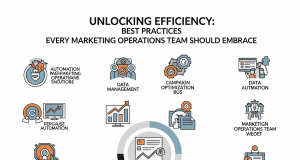In today’s digital landscape, the intersection of technology and marketing has become increasingly vital. A well-structured marketing technology (Martech) stack can propel an organization toward achieving its marketing goals. However, creating an effective Martech stack is not just about investing in the latest tools. Organizations need to focus on maximizing their return on investment (ROI). Here are strategic approaches to building a cost-effective Martech stack that delivers value.
1. Assess Current Needs and Goals
Understand Your Objectives
Before acquiring tools, clearly define your marketing objectives. Are you aiming to improve customer engagement, drive conversions, or enhance analytics? Knowing your goals will streamline decision-making and reduce unnecessary expenditures.
Audit Existing Tools
Conduct a thorough audit of your current Martech tools. Identify which tools are fulfilling your needs and which are redundant. Eliminate overlap to avoid paying for services you don’t use.
2. Prioritize Integration Capabilities
Look for Interoperability
Select tools that integrate seamlessly with one another. A cohesive Martech stack promotes data sharing and reduces manual data entry, which can save time and money. Consider platforms with open APIs to facilitate future integrations.
Unified Dashboard
Use centralized dashboards to monitor performance across various channels. This not only simplifies reporting but can also provide insights that help in refining marketing strategies.
3. Choose Scalable Solutions
Adapt to Growth
Invest in tools that can scale alongside your organization. Whether you’re a startup or an established enterprise, choose solutions that accommodate growth without incurring substantial additional costs.
Flexible Pricing
Consider platforms that offer tiered pricing models. This way, you can start with essential features at a lower cost and upgrade as your needs grow.
4. Emphasize Data Management and Analytics
Data Collection and Management
Implement a robust Customer Relationship Management (CRM) system. A good CRM centralizes customer data and allows for better segmentation, targeting, and personalization of marketing efforts.
Analyze and Optimize
Utilize advanced analytics tools to gauge campaign effectiveness. Understanding what works and what doesn’t can mitigate wasted expenditure and inform future marketing strategies.
5. Invest in Training and Support
Employee Training
Ensure that your team is well-trained on the tools they’ll be using. Increased proficiency can lead to improved overall productivity and effective utilization of the tools.
Dedicated Support
Select vendors that provide robust customer support. In situations where issues arise, having reliable support helps you resolve problems quickly, minimizing downtime and lost revenue.
6. Leverage Automation
Streamlined Processes
Marketing automation can significantly reduce manual workloads. Use automation for tasks like email marketing, social media posting, and lead scoring, allowing your team to focus on strategic initiatives.
Personalization at Scale
Automate personalized communications to enhance customer experiences without the need for extensive manual labor. This can lead to higher engagement rates and, consequently, better ROI.
7. Pilot Programs and Phased Implementation
Test Before You Invest
Consider running pilot programs for new tools before fully committing. This allows you to evaluate effectiveness and validate ROI before making significant investments.
Phased Rollout
Implement your Martech solutions in phases. This strategy can help manage costs and reduce the risk of disruption while allowing time for proper training and adaptation.
8. Evaluate Performance Regularly
KPIs and Metrics
Establish key performance indicators (KPIs) to measure the success of your Martech investments. Regularly reviewing these metrics helps in identifying tools that may not be delivering the expected ROI.
Continuous Improvement
Use these insights to continuously refine your stack. Marketing is a dynamic field, and your tech stack should evolve accordingly to maximize efficiency and effectiveness.
Conclusion
Creating a cost-effective Martech stack is not just about selecting the latest tools; it requires a strategic approach. By thoroughly understanding your needs, emphasizing integration, focusing on data management, investing in training, leveraging automation, and regularly evaluating performance, organizations can maximize ROI on their marketing technology investments. A well-planned Martech stack can streamline processes, enhance customer experiences, and ultimately drive success in a competitive digital landscape.









